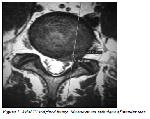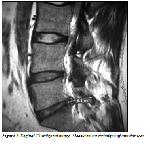Study Design
Two hundred and seventy patients who were operated due to lumbar disc herniation in our clinic, between November 2012 and December 2014 were reviewed retrospectively with the permission of local ethic committee. Patients were operated via standard microsurgery method by the same surgical team (IE, EO, RS, FB, GS). Eighteen patients were detected with early recurrent disc herniation (Group I). Eighteen patients without recurrent disc herniation (Group II) selected randomly and were included in the study. Group I included the patients who had recurrent disc herniation at the same side and less than 6 months. Group II consisted of the patients with no recurrent disc herniation at the same side or another level within 2 years follow-up.
Surgical Technique
All patients were operated in the same center by the same surgical team experienced at least 5 years. In all patients standard microsurgical interlaminar approach has been performed. Partial medial facetectomy has been performed if required and in all patients a rectangular incision of annular fibrosus has been performed to remove protrude or extruded disk fragments using 15 No. blade. Loose nucleus pulposus fragments were removed by disk rongeour although did not force to remove all disk contents.
Patient Selection
Two hundred and seventy patients who were operated via single level microdiscectomy procedure were reviewed retrospectively and the patients who had multi-level disc herniations with or without modic degenerations were excluded from study. The 18 patients with recurrent disc herniation occurred in a time period less than 6 months were included to study (Group I). Other 18 patients in control group were selected randomly (Group II). Mean age was 49,77 years in Group I and 46.5 years in Group II. Group I included 10 female and 8 male patients, where the Group II had 8 female and 10 male patients. For the Group I the operated disk herniation level was L4-5 for 12 patients, L5-S1 for 4 patients and L3-L4 for 2 patients. Average recurrence time was 11.6 weeks for Group I. All 36 patients had ordinary lumbar MRI (Sagittal and axial plane for T1 and T2 weighted images) without contrast administration. There were no signs of apparent instability findings before the surgery noted in Group II and I.
Among 252 patients, 18 patients who are under follow-up at least for 2 years were selected randomly and annular tear diameters were measured by a radiologist (Group II). Size of the annular rupture in Group I, patients who were reoperated because of recurrent disc hernia within the first 6 months, was measured by the same radiologist. Fifteen of the patients in Group I were reoperated via short lumbar segment stabilization with fusion and rediscectomy due to risk of second recurrence. Three of the patients refused the recom-mended surgery.
Patient Evaluation
The lumbar MRI examinations of the 36 patients (Group I and Group II) were evaluated by at least ten year experienced radiologist retrospectively. The annular rupture was characterized as a hyperintense area on T2-weighted images and show contrast enhancement on postcontrast MR images radiologically 7.
In the literature postcontrast T1-weighted images have been found more sensitive than the hiperintensity of the T2-weighted images for detecting annular ruptures 8,9. Unfortunately all preoperative lumbar MRI exami-nations did not have postcontrast images, so we choose the T2-weighted images in order to evaluate the annular rupture.
All MRI examinations had sagittal and transverse T2-weighted images. The right-left diameter of the annular ruptures, characterised as hyperintense area on T2-weighted images, were measured using both the transvers and sagital images. We measured the diameter on the transverse T2-weighted images by checking the extensions of it on the sagital T2-weighted images (Figure 1, Figure 2).

Click Here to Zoom |
Figure 1: Axial T2 weighted image. Measurement technique of annular tear. |

Click Here to Zoom |
Figure 2: Sagittal T2 weighted image. Measurement technique of annular tear. |
Statistical Analysis
In the statistical analysis, mean annular rupture diameter
in the recurrence group was measured as 18.87
(minimum 7mm-maximum 28.6 mm; sd ±6.29) whereas
mean annular rupture diameter in the nonrecurrent
group was found as 8.82 (minumum 5.5mmmaximum
14.5mm; sd ±2.83) (Table 1). Using the
SPSS statistic soft ware program with Mann Whitney
U test the diameter of the annular rupture in the nonrecurrence
group was found statistically and significantly
lower than the recurrence group (p <0.001).



